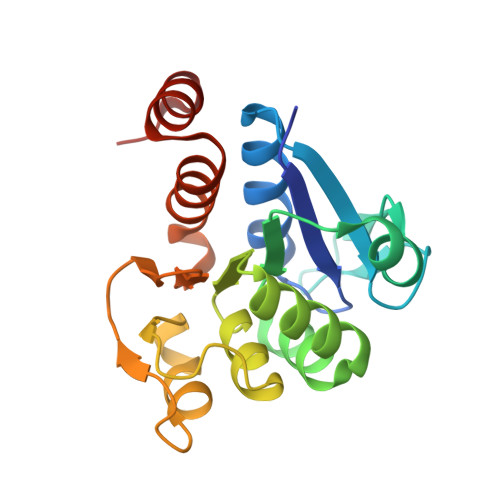Short Carboxylic Acid-Carboxylate Hydrogen Bonds Can Have Fully Localized Protons.
Lin, J., Pozharski, E., Wilson, M.A.(2017) Biochemistry 56: 391-402
- PubMed: 27989121
- DOI: https://doi.org/10.1021/acs.biochem.6b00906
- Primary Citation of Related Structures:
5SY4, 5SY6, 5SY9, 5SYA - PubMed Abstract:
Short hydrogen bonds (H-bonds) have been proposed to play key functional roles in several proteins. The location of the proton in short H-bonds is of central importance, as proton delocalization is a defining feature of low-barrier hydrogen bonds (LBHBs). Experimentally determining proton location in H-bonds is challenging. Here, bond length analysis of atomic (1.15-0.98 Å) resolution X-ray crystal structures of the human protein DJ-1 and its bacterial homologue, YajL, was used to determine the protonation states of H-bonded carboxylic acids. DJ-1 contains a buried, dimer-spanning 2.49 Å H-bond between Glu15 and Asp24 that satisfies standard donor-acceptor distance criteria for a LBHB. Bond length analysis indicates that the proton is localized on Asp24, excluding a LBHB at this location. However, similar analysis of the Escherichia coli homologue YajL shows both residues may be protonated at the H-bonded oxygen atoms, potentially consistent with a LBHB. A Protein Data Bank-wide screen identifies candidate carboxylic acid H-bonds in approximately 14% of proteins, which are typically short [⟨d O-O ⟩ = 2.542(2) Å]. Chemically similar H-bonds between hydroxylated residues (Ser/Thr/Tyr) and carboxylates show a trend of lengthening O-O distance with increasing H-bond donor pK a . This trend suggests that conventional electronic effects provide an adequate explanation for short, charge-assisted carboxylic acid-carboxylate H-bonds in proteins, without the need to invoke LBHBs in general. This study demonstrates that bond length analysis of atomic resolution X-ray crystal structures provides a useful experimental test of certain candidate LBHBs.
Organizational Affiliation:
Department of Biochemistry and Redox Biology Center, University of Nebraska , Lincoln, Nebraska 68588, United States.















